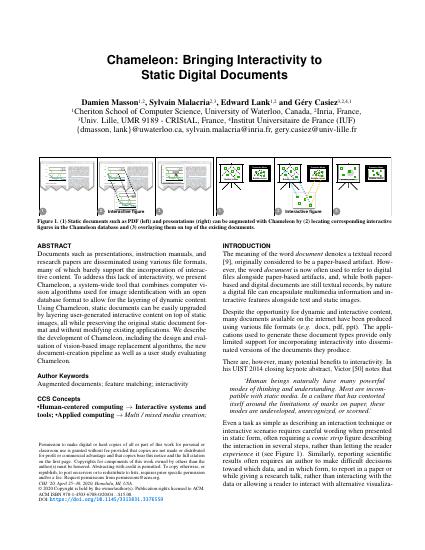Chameleon: Bringing Interactivity to Static Digital Documents
In Proceedings of the 2020 CHI Conference on Human Factors in Computing Systems (CHI '20).Acceptance Rate: 24% (760/3126)
Damien Masson, Sylvain Malacria, Edward Lank, Géry Casiez


About
Chameleon is a software allowing authors to incorporate interactive and animated figures into any digital document (any format, past, present or future).
How it works
Chameleon combines feature matching algorithms with a database of HTML5 figures. Chameleon works by analysing on-screen pixels and overlaying HTML5 content; when seen by Chameleon, registered figures are replaced by their interactive versions.
Results
A comparison of computer vision algorithms revealed that SURF and BRISK are the most accurate feature matching algorithms when tasked to locate on-screen digital figures. See the charts below for detailed results.
With optimized parameters, Chameleon was found to accurately find more than 94% of figures, and a user study showed that participants would use Chameleon over any other alternative.Abstract
Documents such as presentations, instruction manuals, and research papers are disseminated using various file formats, many of which barely support the incorporation of interactive content. To address this lack of interactivity, we present Chameleon, a system-wide tool that combines computer vision algorithms used for image identification with an open database format to allow for the layering of dynamic content. Using Chameleon, static documents can be easily upgraded by layering user-generated interactive content on top of static images, all while preserving the original static document format and without modifying existing applications. We describe the development of Chameleon, including the design and evaluation of vision-based image replacement algorithms, the new document-creation pipeline as well as a user study evaluating Chameleon.



